Key Insights
- USDC solidified itself as the leading stablecoin with $1.5 billion in trading volume, up 168% QoQ. In Q4, Circle launched CCTP on Noble, and in Q1, SKIP enabled native USDC bridging with Solana.
- Osmosis DEX trading volume reached $5.3 billion, up 113% QoQ and 783% over the past six months. Osmosis introduced volume splitting incentives, recalibrating incentives each epoch, targeting liquidity towards high-traffic, lower-fee pools.
- Osmosis revenue reached $11.2 million, up 63% QoQ and 700% over the past six months. Revenue was boosted by the implementation of a 0.1% taker fee on trades.
- IBC inflows reached $1.7 billion, and outflows climbed to $2.1 billion, resulting in a net outflow of $357 million. The increase in IBC activity is correlated with the launches of Celestia and DYDX, CCTP on Noble, Dymension, and general market conditions.
Primer
Osmosis (OSMO) is a sovereign decentralized exchange (DEX) within the Cosmos ecosystem, focusing on automated market making (AMM) and liquidity provision. Osmosis distinguishes itself through its AMM as serviced functionality and customizable liquidity pools that allow for detailed adjustments in trading parameters.
The OSMO token plays a key role in governance and transaction fee operations. Token holders participate in protocol governance, impacting decisions on protocol upgrades and liquidity reward strategies. Transaction fees on the network are paid in OSMO and are distributed to stakers. The ProtoRev model uses the OSMO token for minting and burning to maintain onchain price balance. Trade taker fees are allocated partly to the Community Pool, with the rest benefiting stakers. Additionally, OSMO is involved in superfluid staking, which connects liquidity pool stakes to the network’s security.
Osmosis is the primary liquidity hub and trading venue of the Cosmos ecosystem. As an app chain, it supports the development of numerous complementary apps. Recently, Osmosis has added features like stableswap, concentrated liquidity, rate-limiting, and in-protocol MEV capture. These developments underscore its ongoing expansion as a full-service, cross-chain DeFi hub.
Website / X (Twitter) / Discord
Key Metrics

Analysis
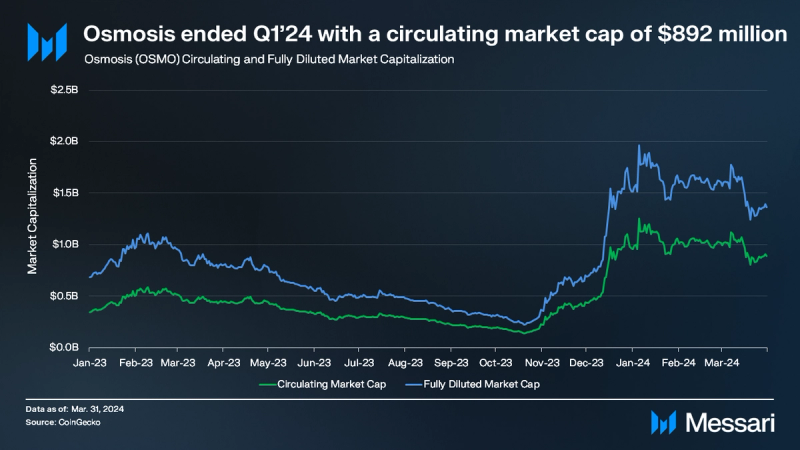
In Q1 2024, OSMO’s circulating market cap decreased to $892 million (-7% QoQ), while the fully diluted market cap decreased to $1.4 billion (-10% QoQ). The circulating supply of OSMO rose by 20 million to a total of 653 million, representing a 3.1% QoQ inflation (12.4% annualized). This increase was responsible for the discrepancy between the changes in the circulating and fully diluted market caps. Osmosis has a maximum total supply of 1 billion OSMO tokens; therefore, 65.3% of the supply is in circulation. Osmosis is rolling out an OSMO token burn of MEV tokens collected by the protocol.
OSMO’s market cap ranking fell to approximately 125th among all networks. Within the Cosmos ecosystem, it remained among the five largest assets by market cap.
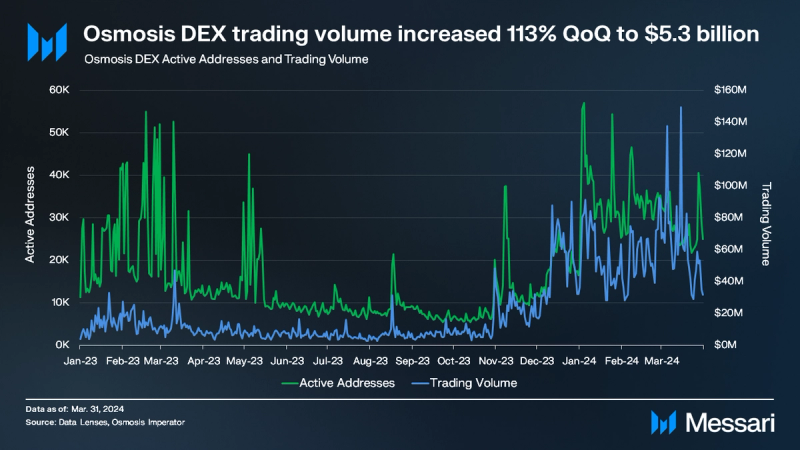
In Q4 2023, Osmosis implemented two critical upgrades aimed at enhancing liquidity efficiency and revenue generation: volume splitting incentives and a 0.1% taker fee. During Q1 2024, these updates led to further growth in Osmosis DEX activity. Daily active addresses rose to 32,000 (+140%) and trading volume reached $5.3 billion (+113% QoQ). Revenue also grew, totaling $11.2 million (+63% QoQ).
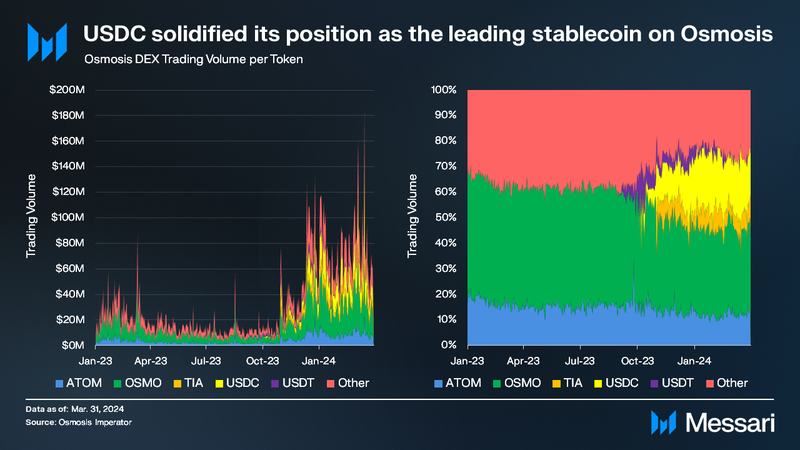
Q1 2024 trading volume data illustrates a diverse performance among the leading tokens on Osmosis DEX. OSMO continued as the leading asset with a trading volume of $2.3 billion (+77% QoQ). ATOM saw a +65% QoQ increase, while TIA’s trading volume reached $463 million, a +100% QoQ increase. USDC notably increased its trading volume by nearly $1 billion (+168%), benefiting from Circle’s CCTP launch on Noble and Skip’s API bringing native USDC from Solana. In contrast, USDT experienced a -50% drop in trading volume. The collective trading volume of assets outside the top five increased to $1.6 billion, marking a +73% QoQ increase.
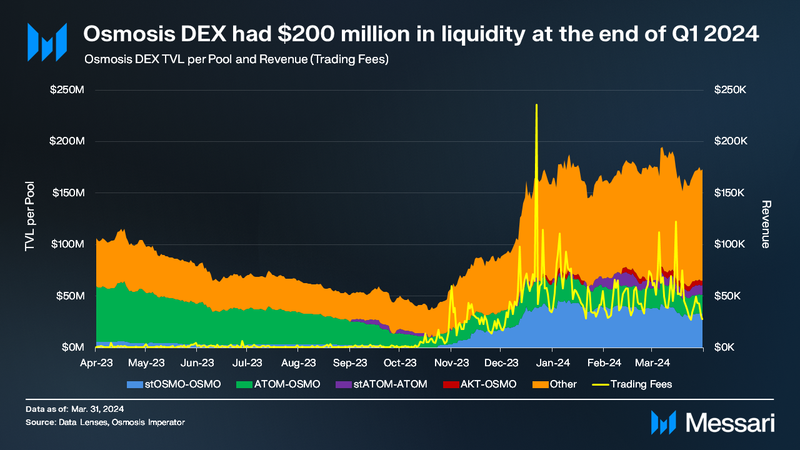
Q1 2024’s TVL in Osmosis DEX’s pools was relatively flat at $199 million, a slight +1.2% QoQ increase but a significant +160% increase since Q3 2023.
Liquidity efficiency saw significant improvement in 2023 due to Supercharged Liquidity, allowing users to concentrate their liquidity around specific price ranges. In Q1 2024, Osmosis announced the integration of Astroport’s Passive Concentrated Liquidity (PCL) pools which provide users with the advantages of concentrated liquidity pools without the need for active management. Together these two options give Osmosis LPs more optionality and pool types to choose from.
Overall, the stOSMO-OSMO pool led with a TVL of $33 million, followed by ATOM-OSMO at $18 million. One of the fastest growing pools was a wstETH pool which was seeded with 1 million AXL and has grown to over $700,000. The cumulative TVL for other pools was $108 million, suggesting a healthy diversification of liquidity.
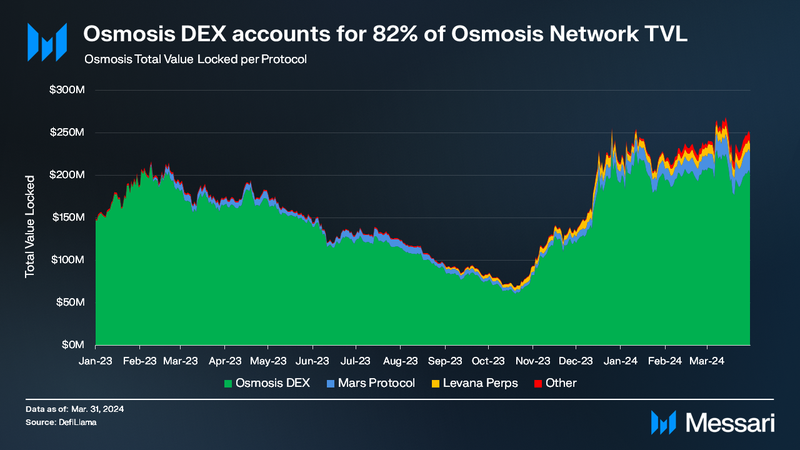
For Q1 2024, the distribution of TVL across protocols in the Osmosis network was unchanged. Osmosis DEX maintained its position as the largest protocol with a TVL of $202 million, accounting for 82% of the Osmosis Network TVL. Mars Protocol and Levana Perps experienced growth in their respective TVLs, with Mars up 93% QoQ to $25 million and Levana up 23% QoQ to $10 million. The collective TVL for other protocols reached $10 million.
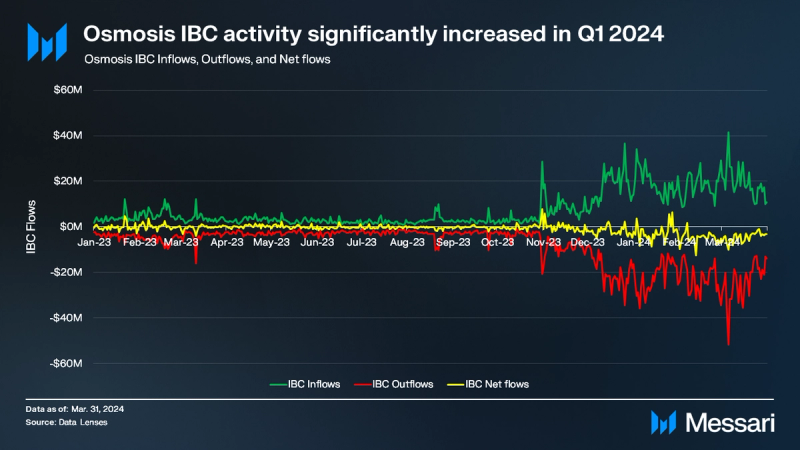
IBC flows in Q1 2024 showcased increased cross-chain interactions via the Osmosis network. IBC inflows reached $1.7 billion, and outflows climbed to $2.1 billion, resulting in a net outflow of $357 million. The increase in IBC activity is correlated with the launches of Celestia and DYDX, CCTP on Noble, Dymension, and general market conditions. This marks a considerable rise in cross-chain activity, highlighting the growing relevance and functionality of IBC in facilitating ecosystem interoperability.
Recent notable events from the Osmosis ecosystem include:
- Osmosis integrated Bitcoin in collaboration with Nomic and Kujira, facilitating Bitcoin transfers to the Cosmos network via the Nomic bridge at a 1.5% transaction fee. This process issues Nomic Bitcoin (nBTC).
- Osmosis announced a planned merger with Umee’s UX Chain, introducing cross-chain lending features such as margin trading, liquidations, and flash loans.
- The launch of Token Info Pages, offering deeper insights into the tokens hosted within the Osmosis DEX.
- The launch of the Staking Dashboard to improve the staking UX.
- The launch of the first NFT collection Mad Scientists.
Closing Summary
Q1 2024 marked a period of continued development and growth for Osmosis, evident across several key performance metrics. The platform’s trading volume increased to $5.3 billion, a 113% rise from the previous quarter. Daily active addresses grew to 32,000, and revenue rose to $11.2 million, up 63%.
Osmosis was recognized as a leading DeFi project by developer activity. This status is exemplified by innovations such as Supercharged Liquidity and the partnership with Astroport for integrating Passive Concentrated Liquidity pools. These efforts have improved liquidity efficiency and expanded the platform’s functionality. With over 150 assets listed, increasing IBC activity, and more partnerships, Osmosis is positioned for continued growth and influence through 2024.



















